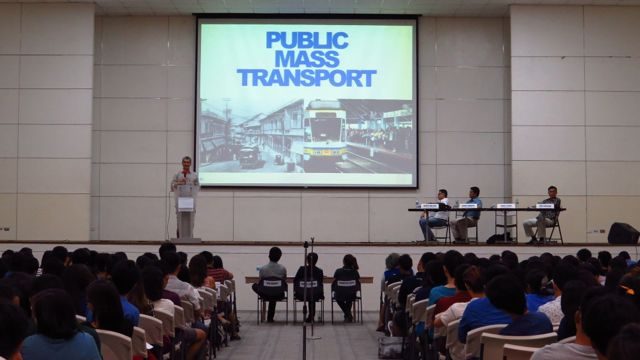SUMMARY
This is AI generated summarization, which may have errors. For context, always refer to the full article.

MANILA, Philippines – When it comes to the Metro Rail Transit (MRT3), there’s one point everyone seems to agree on: the aging train line that services over half a million commuters in Metro Manila is running over capacity, and its repairs and maintenance are long overdue.
But when it comes to raising fares to fund the upkeep of the system, various sectors are split: some are in favor of the price increase, saying it’s only fair that MRT riders pay for the service they use.
Others, however, say the MRT benefits non-riders too, and they should also contribute their share for a railway system that benefits the entire country.
A new fare scheme on the MRT and the Light Rail Transit (LRT) took effect in January. Under the new scheme, maximum rides on the train lines now cost between P28-30 ($0.63-0.67), from the previous P15-20 ($0.34-0.45).
In a forum on Friday, March 6, representatives from the academe, non-governmental organizations, and the MRT discussed the fare hike and other issues in the mass transport system in the Philippines.
The forum, organized by the UP School of Economics Student Council and the UP Economics Towards Consciousness, was held at the University of the Philippines-Diliman.
User-pays principle
In his presentation, transport geography professor Daniel Mabazza noted that the government has spent around P12 billion every year to subsidize passengers using the MRT and LRT.
He added that the failure to match fares with higher operating costs have “crippled [the train lines’] ability to invest in large-scale improvements” for their facilities because the revenues “have only been enough for day-to-day operations.”
If fares are adjusted and riders pay more for the train services they use, Mabazza said an estimated P2 billion will be freed up for development projects that could be used in other parts of the Philippines, not just Metro Manila.
This, Mabazza added, is in keeping with the user-pays principle, that consumers pay for the cost of the goods and services they use.
He also asked why the 86 million people who do not use the train lines should subsidize the less than 14 million train passengers.
“Bakit magbabayad ang 86 million para sa mas mababa na 14 million na gumagamit ng MRT at LRT? Hindi rin naman buong Metro Manila ang nakikinabang kasi hindi covered lahat [ng mga ruta],” he said.
(Why should the 86 million others pay for the less than 14 million passengers of the MRT and LRT? Not everyone in Metro Manila use the train line because the routes don’t cover the entire area.)
Civil engineer Rene Santiago also pointed out that majority of commuters won’t benefit because train riders make up only a small portion of the entire transport mode mix.
“You are subsidizing MRT riders, you are not subsidizing the other trip makers. The poorest of the poor normally take the jeep….So if you want to benefit majority of commuters, rich and poor, you have to address the [other modes of transportation used by] 70% [of commuters] rather than the 7% [of train riders] costing us billions of pesos,” he added.
Meanwhile, MRT3 officer-in-charge Renato San Jose noted that in other countries, it’s normal for users to pay premium for faster mobility.
“Fare increase is not removing the [government’s] subsidy….In other countries, riders pay premium for faster transport they use. Hindi naman siguro masama na kung medyo gusto mo mag-benefit, mag-share ka sa cost,” he said.
Non-riders benefit, too
But Sonny Africa, president of NGO IBON Foundation, said that non-riders stand to benefit from the trains too.
Because of this, all beneficiaries of the railway system should contribute, he said.
“The rail system benefits not just the user, it benefits property developers along the railway and mall owners where the train stations are located. Even private vehicle owners benefit from less traffic, less congestion, they gain more time,” he said.
He added: “The mass transport system enhances productivity, reduces air pollution, and minimizes energy use. May pakinabang sa mass transport system beyond sa pakinabang sa pasahero (The mass transport system not only benefits the passengers). If we reframe [the issue] this way, those who benefit from the rails are not just commuters, so those who should pay for it should not just be the commuters too.”
Africa also stressed that public transport should be seen as an essential public service.
“Kailangan kilalanin ang nature of public transport as an essential service. Yes, the user should pay, but all beneficiaries should pay,” he said.
Africa also raised another suggestion to the government: don’t be afraid of the rich.
“The government has a political choice….The government shouldn’t be afraid of charging mall owners for the increased traffic, of charging private vehicle owners who account for only 30% of travel but 70% of traffic in Metro Manila,” he said. – Rappler.com
$1=P44.68
Add a comment
How does this make you feel?
There are no comments yet. Add your comment to start the conversation.